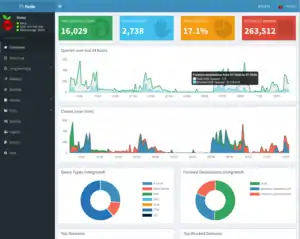Pi-hole
Pi-hole is a Linux network-level advertisement and Internet tracker blocking application[2][3][4][5] which acts as a DNS sinkhole[6] and optionally a DHCP server, intended for use on a private network.[1] It is designed for use on embedded devices with network capability, such as the Raspberry Pi,[3][7] but it can be used on other machines running Linux, including cloud implementations.[6][8][9][10]
 Screenshot of the AdminLTE web interface for Pi-hole | |
| Developer(s) | Pi-hole, LLC[1] |
|---|---|
| Initial release | June 15, 2015 |
| Stable release | v5.2.4
/ January 19, 2021 |
| Repository | github |
| Written in | Bash, PHP (optional web server), C (optional DNS server FTLDNS) and CSS |
| Operating system | Linux |
| Licence | European Union Public Licence |
| Website | pi-hole |
Pi-hole has the ability to block traditional website advertisements as well as advertisements in unconventional places, such as smart TVs and mobile operating system advertisements.[11][12]
History
The Pi-hole project was created by Jacob Salmela as an open source alternative to AdTrap[13][14] in 2014[15] and was hosted on GitHub.[16] Since then, several contributors have joined the project.[15]
Features
Pi-hole makes use of a modified dnsmasq called FTLDNS,[17] cURL, lighttpd, PHP and the AdminLTE Dashboard[18] to block DNS requests for known tracking and advertising domains. The application acts as a DNS server for a private network (replacing any pre-existing DNS server provided by another device or the ISP), with the ability to block advertisements and tracking domains for users' devices.[2] It obtains lists of advertisement and tracking domains from a configurable list of predefined sources, and compares DNS queries against them. If a match is found within any of the lists, or a locally-configured blacklist, Pi-hole will refuse to resolve the requested domain and respond to the requesting device with a dummy address.[19]
Because Pi-hole blocks domains at the network level, it is able to block advertisements, such as banner advertisements on a webpage, but it can also block advertisements in unconventional locations, such as on Android, iOS and smart TVs.[9][11]
Using VPN services, Pi-Hole can block domains without using a DNS filter setup in a router. Any device that supports VPN can use Pi-Hole on a cellular network or a home network without having a DNS server configured.[20]
The nature of Pi-hole allows it to also block website domains in general by manually adding the domain name to a block-list. Likewise, domains can be manually added to an allow-list should a website's function be impaired by domains being blocked. Pi-hole can also function as a network monitoring tool,[21] which can aid in troubleshooting DNS requests and network faults.[9] Pi-hole can also be used to encourage the use of DNS over HTTPS for devices using it as a DNS server with the cloudflared binary provided by Cloudflare.[22]
Difference from traditional advertisement blockers
Pi-hole functions similarly to a network firewall, meaning that advertisements and tracking domains are blocked for all devices behind it, whereas traditional advertisement blockers only run in a user's browser, and remove advertisements only on the same machine.[9][23]
References
- "Pi-hole®: A black hole for Internet advertisements". Pi-hole®: A black hole for Internet advertisements. Retrieved 2018-04-15.
- "Pi-hole is a black hole for internet ads #piday #raspberrypi @Raspberry_Pi". Adafruit Industries - Makers, hackers, artists, designers and engineers!. 2016-03-04. Retrieved 2018-05-06.
- "Turn A Raspberry Pi Into An Ad Blocker With A Single Command". Lifehacker Australia. 2015-02-17. Retrieved 2018-05-06.
- Leathern, Rob (2015-12-23). "Block Ads on All Home Devices for $53.18". Rob Leathern. Retrieved 2018-05-06.
- "Adblock Everywhere: The Raspberry Pi-Hole Way". MakeUseOf. Retrieved 2018-05-06.
- "pi-hole/pi-hole". GitHub. Retrieved 2018-04-15.
- "Pi-hole hardware kit". Pi-hole hardware kit. 2018-05-07. Retrieved 2018-05-08.
- "Pi-Hole in the cloud · Cody Bunch". blog.codybunch.com. Retrieved 2018-05-06.
- "Seven Things You May Not Know About Pi-hole". Pi-hole®: A black hole for Internet advertisements. 2017-05-12. Retrieved 2018-05-06.
- "AdBlocking with Pi-Hole and Ubuntu 14.04 on VirtualBox". hbalagtas.blogspot.co.uk. Retrieved 2018-05-06.
- "Ad-Blocking on Apple iOS9: Valuing End User Experiences - Catchpoint Blog". Catchpoint's Blog - Web Performance Monitoring. 2015-09-14. Retrieved 2018-05-06.
- "Running a Network-wide Ad-blocker, and a Whole Lot More". CryptoAUSTRALIA Blog. 2017-11-02. Retrieved 2018-05-06.
- "Block Millions Of Ads Network-wide With A Raspberry Pi-hole 2.0". Jacob Salmela. 2015-06-16. Retrieved 2018-04-15.
- "Pi-hole: A Raspberry Pi Ad-Blocker with DNS Caching (Ultra-fast)". Jacob Salmela. 2014-06-11. Retrieved 2018-05-06.
- "pi-hole/pi-hole; Contributors". GitHub. Retrieved 2018-05-06.
- Jeffries, Adrianne (2018-05-10). "Inside the Brotherhood of the Ad Blockers". Bloomberg.
- telekrmor (2018-02-22). "FTLDNS: Pi-hole's Own DNS/DHCP server". Pi-hole®: A black hole for Internet advertisements. Retrieved 2019-11-10.
- "pi-hole/pi-hole; The Origin Of Pi-hole". GitHub. Retrieved 2018-04-15.
- "How does Pi-hole work?". Pi-hole Userspace. Retrieved 2018-05-06.
- "Overview - Pi-hole documentation". docs.pi-hole.net. Retrieved 2019-08-11.
- "What Really Happens On Your Network? Find Out With Pi-hole". Pi-hole®: A black hole for Internet advertisements. 2017-02-22. Retrieved 2018-05-06.
- "Configuring DNS-Over-HTTPS on Pi-hole - Pi-hole documentation". docs.pi-hole.net. Retrieved 2020-11-01.
- "Enjoy The Rio Olympics Ad-free With Pi-hole". Pi-hole®: A black hole for Internet advertisements. 2016-08-11. Retrieved 2018-05-06.